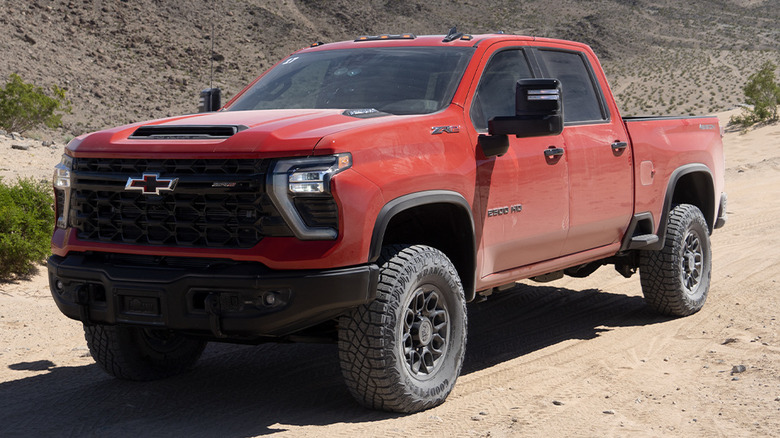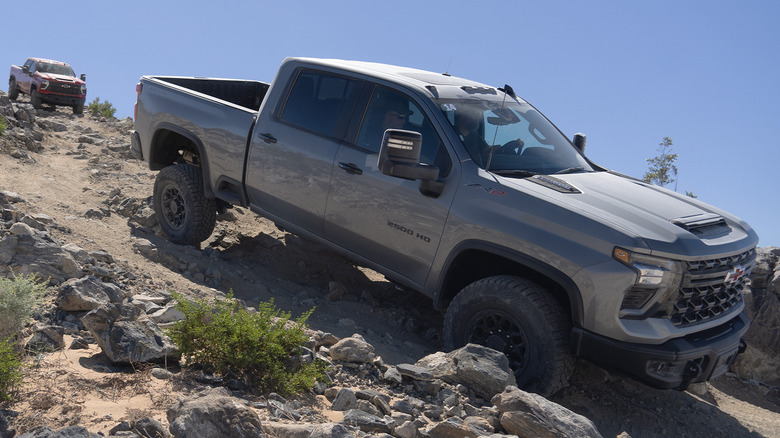Light Duty Vs Heavy Duty Trucks Explained: What's The Difference?
We just spent a day out in Johnson Valley with Chevrolet testing the new "Bison Family" of hardcore off-roading pickup trucks. After the success of last generation's Colorado ZR2 Bison, the package now expands to Silverado with a similar set of upgrades built in partnership with American Expedition Vehicles (AEV) and suspension specialists at Multimatic. The mid-sized Colorado ZR2 Bison, in particular, stands out thanks new chassis mounting points for the Multimatic dampers, plus a new set of nifty hydraulic jounce control dampers.
For the first time, the Silverado lineup also receives ZR2 and Bison packages for both the Light Duty and Heavy Duty (1500 and 2500) pickups. And now for 2024, both the Silverado LD and HD in ZR2 or Bison trim come with a diesel engine as standard, as Chevy relegates the gasoline V8 to an option box in favor of a 3.0 or 6.6-liter Duramax. But a wild day spent off-roading the HD Bison begs the question: Other than engine options, what's the real difference between Light Duty and Heavy Duty trucks?
Heavy Duty trucks for hard service lives
Technically speaking, the NHTSA recognizes Light Duty trucks as running up to a gross vehicular weight rating of 10,000 pounds—not so for OEM nomenclature, which is really more like guidelines. Some companies use Light Duty and Heavy Duty, while others prefer the distinction of Super Duty. But the general purpose shines through regardless: These trucks were designed and engineered with hard work and heavy towing in mind.
That means big diesel and gasoline engines, plus beefy transmissions to route that power to the ground. Throw on some stronger springs, steering components, additional cooling capacity, thicker axles, bigger brakes—anything that can help a truck withstand the rough and tumble service life of towing, hauling, road trips, or off-roading.
For Chevy in particular, though, the difference between LD and HD is a bit, well, different. That's because Chevy decades ago decided to ditch solid front axles in favor of independent front suspension that uses torsion bars and shock dampers. This layout means both the LD and HD Silverado—including the ZR2 and Bison—do not use coil springs front nor rear, as opposed to the Ford Raptor and Toyota Tundra's four coilsprung corners, or the solid front axles of 2500 and 3500-class Ram and Ford trucks. (Note that Chevy's 3500 similarly uses IFS and torsion bars.)
Chevrolet's unusual Heavy Duty decision
That doesn't mean either a LD or HD Silverado, including the Bison package, shouldn't be considered a true light duty or heavy duty truck just because they only use a solid rear axle. The tradeoff will sound familiar to fans of Jeep's dedicated off-roading Wrangler and Gladiator, both of which use solid front and rear axles to increase predictable articulation during hardcore four-wheeling. Instead, the decision to stick with IFS and torsion bars prioritizes improved on-road driving manners, absorbing cracks and bumps without the less refined steering feel and tendency towards tramlining that solid front axles often produce.
Chevy's engine options don't disappoint, either: The LD ZR2 now gets a 3.0-liter turbodiesel inline-six rated at 305 horsepower and 495 lb-ft of torque, with the shared GM-Ford ten-speed automatic sending power to the rear or all four wheels through a two-speed transfer case. Meanwhile, the HD ZR2 Bison employs a hefty 6.6-liter turbodiesel V8 that steps up to 470 horsepower and 975 lb-ft, plus a heavy duty 10-speed auto built by Allison.
A hard decision between LD and HD Silverados
The HD, therefore, can tow up to 18,500 pounds, versus the LD's 8,700-pound tow rating. But adding AEV's steel front and rear bumpers, cold-stamped boron skid plates, onto an HD pickup with an enormous V8 and beefed-up drivetrain results in a stunning curb weight of 8,495 pounds—not exactly the best for off-roading. Really, Chevy intends the HD Bison to serve best as a tow rig for off-road toys, capable of leaving the pavement long enough to unload gear and then truly head for the horizon.
Unfortunately, the LD Bison pales a bit in comparison, regardless of the choice between a gasoline or diesel engine. Instead of bigger tires and better suspension, the Bison only gets the armoring. At first, that decision seemed like a concession to fleet fuel economy averages, but Chevy's engineers on hand at Johnson Valley admitted that the current 1500 Silverado chassis was not originally designed with the packaging that a Bison with 35-inch tires would require. (Hold please, coming for the next generation, soon perhaps, but of course not quite confirmed.)
The ZR2 and ZR2 Bison's popularity on the mid-sized Colorado made the decision to add the packages to the Silverado LD and HD a no-brainer. And switching to a base diesel for both trucks certainly ups the enticement of both, now that the Colorado is gasoline-only. But for buyers who want the best of both worlds in a full-sized pickup truck, the difference between LD and HD Bison present something of a quandary. Both are definitely big trucks capable of far more than expected, but the step up from light to heavy duty at Chevrolet means less than the difference between 1500 and 2500 classes at Ram or Ford.



